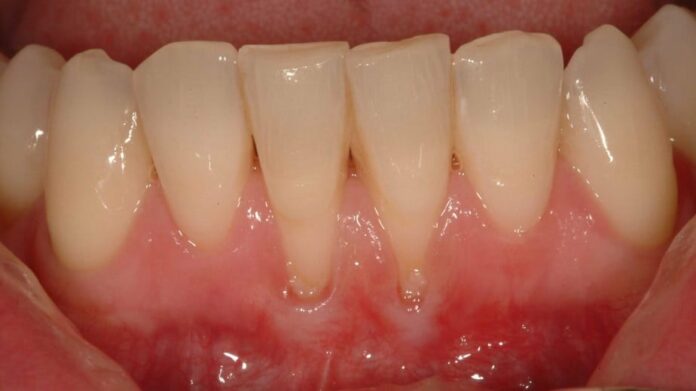The Problem of Gum Recession and Exposed Tooth Roots
Gum recession is a common issue that often leads to misunderstandings regarding its causes and prevention. By simplifying the topic, we can shed light on the reasons behind gum recession and explore methods to promote gum regrowth. Let’s begin by understanding the implications of gum recession and the exposure of tooth roots.
The Vulnerability of Exposed Tooth Roots
When gum recession occurs, the part of the tooth’s root that is normally protected by enamel becomes exposed. While the enamel covering ends at the gum line, receding gums leave the root vulnerable to damage. Unlike enamel, which has the ability to repair and regenerate itself daily, the cement covering the root lacks this self-repair mechanism. As a result, the exposed root becomes susceptible to acid attacks and the erosive effects of sugary substances. Gradually, the tooth may wear away, leading to sensitivity and discomfort.
The Consequences of Tooth Wear and Nerve Exposure
As the tooth wears away due to gum recession, a noticeable dip or missing part may develop in the affected area. This exposed region lacks the protective covering found in the enamel, leaving the tooth vulnerable to pain and sensitivity. The proximity of the nerve in the tooth’s center means that the absence of protection can lead to excruciating pain and discomfort. Traditional treatment methods such as fillings may not always be the best option, as the acidic materials used in the filling process can potentially harm the nerve further.
The Link Between Gum Recession and Tooth Sensitivity
Gum recession not only leads to sensitivity but also increases the risk of tooth decay. The absence of protective enamel and the proximity to the nerve make the exposed area highly susceptible to decay-causing bacteria. Additionally, individuals who consume a high amount of sugary and carbohydrate-rich foods or regularly consume sugary drinks are more prone to tooth decay in this area. It’s crucial to address gum recession promptly to prevent these issues from worsening.
The Importance of Preventive Measures
To promote gum regrowth and mitigate the consequences of gum recession, it is essential to focus on preventive measures. While addressing the underlying causes of gum recession, it’s important to pay attention to oral acidity. Frequent consumption of acidic beverages, failure to balance oral pH before sleep, and dry mouth conditions can contribute to gum recession and enamel erosion. Minimizing acidic exposure and adopting a comprehensive oral care routine can support gum and tooth health.
Strategies for Gum Regrowth
Gum regrowth is possible with a proactive approach to oral care. To initiate gum regrowth, it is recommended to use a toothbrush that stimulates and massages the gums without being too soft. Massaging the gums with a resilient toothbrush can promote the growth of new blood vessels, essential for gum tissue regeneration. Furthermore, incorporating a complete mouth care system that includes specific rinses, Xylitol usage, and appropriate toothpaste can help eliminate potential infections, prevent decay, and encourage the regrowth of the protective biofilm over the teeth.
Harmful Practices to Avoid
Certain practices can be detrimental to gum health and hinder regrowth. Overzealous flossing can cause damage to receding gums, and it is not necessarily the solution to gum recession or infection. Homemade toothpaste formulations containing baking soda, peroxide, or essential oils like clove or neem should be avoided as they can be excessively harsh on the gums and potentially harm the tooth nerve. Additionally, regular dental cleanings may remove the protective biofilm necessary for gum regrowth, so it’s crucial to consider alternative approaches.
Lifestyle Modifications for Optimal Oral Health
In addition to following proper oral care techniques, certain lifestyle modifications can support gum regrowth. Avoiding tooth whitening products that contain strong acids and peroxide is crucial, as they can harm both the gums and the teeth. Limiting the consumption of acidic beverages, such as citrus fruits or drinks, and incorporating Xylitol after meals can help maintain a healthy oral pH. Practicing good sleep, exercise, and stress management habits also contribute to overall oral health and healing.
Patient-Specific Considerations and Expectations
The ability to regrow gum tissue depends on various factors, including the extent of tooth wear and the individual’s overall oral health. While regenerating gum tissue may not be possible in cases where significant tooth surface has been lost, it is still worth adopting preventive measures to maintain the existing gum level and prevent further recession. Consulting a dental professional can provide personalized guidance and determine the best course of action for each individual.
Conclusion
Gum recession can lead to tooth sensitivity, increased susceptibility to decay, and potential nerve damage. Understanding the causes and implementing preventive measures are essential for promoting gum regrowth and overall oral health. By adopting proper oral care techniques, avoiding harmful practices, and making lifestyle modifications, individuals can take control of their oral health and prevent further gum recession. Remember, healthy gums are vital for maintaining strong and resilient teeth throughout life.


